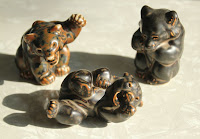Janina Konarska (born Seideman) - Słonimska
Łódź
1900 - 1975 Warsaw
Polish painter, sculptor and woodblock
printmaker
I stumbled upon a print by this Polish
artist and here’s the result of my initial research. Amazingly Janina Konarska is
hardly known outside Poland and all text I could find I had to translate. But
here is: all color woodblock prints I could find shown together for the first time in
this posting.
Born in a family of textile factory
owners she initially was trained as a teacher artist. Later entering the Warsaw Academy of
Fine Arts she was Wladyslaw Skoczylas (1883-1934) printmaker and art educator, favourite student.
In 1918 she adopted the artist name of Konarska, which was officialised in 1924 also for her
daughter Hanka. During
the Polish-Russian War (1918-1921), the fight for Polands' independence, she worked as a nurse treating and caring for the injured soldiers. Janina Konarska exhibited successfully
internationally during the 1920's and 1930's in 1932 winning a medal for her “Skiers” in Los Angeles (US).
Konarska in the 1920’s belonged to Poland’s
inner circle of intellectuals, artists and writers. Her friends described her
as stunningly beautiful: a "Sophie in Soplicowo Garden” hinting at Poland’ s famous literary
national epic epos Pan Tadeuzs (Sir Taddeus) by poet Adam Mickiewicz (1798-1855). Below a still from the 1999 movie (note also the beautiful flowers !)
This 19 pencil sketch below, I could not find any sculptures or paintings by her hand, is of pianist Arthur Rubinstein (1887-1982), with Frederique Chopin (1810-1849) and Pope John Paul II (1920-2005) among the most famous of Polands' sons.
Besides Janina's iconic beauty she was an
intellectual, and a passionate lover of Polish poetry. And, it is said, of Polish poets,
writers and artists. Her turbulent love life was as legendary as her beauty.
In 1934 to anyones surprise she married writer, poet and journalist Antoni Slonimski (1895-1976) gradually ending her own artistic career dedicating the remainder of her
life to her husbands career.
In most of the woodblock prints I’ve found the birds-eye
views and depiction of sporting events is eminent. Janina is buried in Warsaw
along with her husband, who died in a car accident.
All comments, corrections and additions on this posting are warmly
welcomed. See also my posting on Adam Bunsch (1896-1969), very much a contemporary of Janina and also a Polish
printmaker unobscured in this Blog.
All pictures borrowed freely from the Internet for friendly, educational and non commercial use.

































.jpg)





















